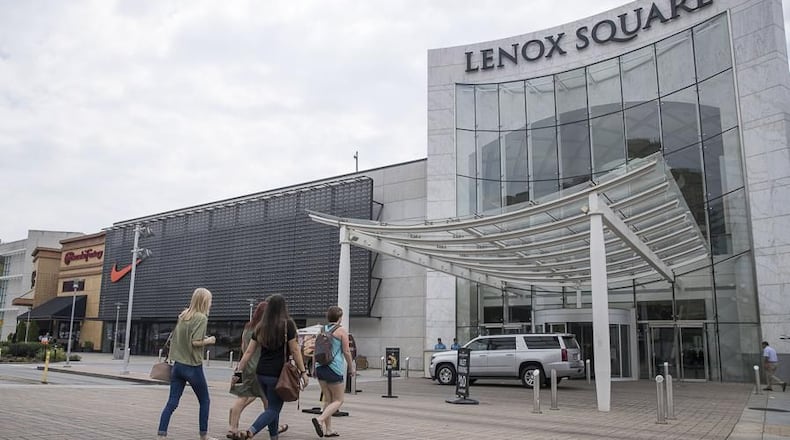For decades, the local mall was the definitive hangout spot for American teenagers. But ask any teenager today and many will tell you, the mall isn’t really the destination that it once was.
“After 15, when you can drive or your friends can drive, the mall gets way less popular,” said Breanna Becnel, a 17-year-old high school senior from Johns Creek. “Most kids are not hanging out at the mall.”
This trend of teens moving away from mall culture likely started in or before the 2010s — the decade that changed the industry, according to retail experts. One Atlanta teen, Madeline Viera, documented the shift as early as 2014 in a story for NPR’s “Morning Edition.” Viera visited Lenox Square and Atlantic Station looking for teenagers and came up empty. Retail workers told her it was preteens, not teens, who were hanging out at the mall.
A few months before that story, Piper Jaffray, an investment banking firm, released its annual report on teen behavior, which revealed a 30% decline in the number of mall visits by teens from a peak in 2007. Reasons for the decline included more teens shopping online or making only need-based purchases rather than impulse shopping, or teens relying on social networks to connect rather than meeting up in person.
A similar characterization of malls and the kids who love them has taken root in popular culture. If one believes that scripted shows streaming on Disney+ reflect anything close to reality, then it is certainly true that middle schoolers are the real mall rats.
The possibility that the mall has lost much of its lure among at least half of the teenage crowd has not deterred a number of area malls from instituting supervision programs, the latest of which was announced last week when Lenox Square in Buckhead revealed a new policy that requires anyone under age 18 to be accompanied by an adult on mall property.
The “youth supervision policy” begins Sept. 21 at 3 p.m. when teenagers looking for a mall fix will have to come with an adult age 21 or older. The policy comes after several shootings involving teens at metro area malls, including one at Lenox Square in June in which a security guard was shot during a botched robbery. The suspects are two 15-year-olds.
Mall representatives declined to be interviewed for this column but in a statement said, “Lenox Square is committed to providing a pleasant and family friendly shopping environment for all of our guests. We are establishing a Youth Supervision Policy to promote a more family friendly environment and to deter disruptive activity.”
Credit: HYOSUB SHIN / AJC
Credit: HYOSUB SHIN / AJC
Placing curfews on teen visitors is a practice that predates the decline in teenage mallgoers by at least a decade. In 1996, the Mall of America was one of the nation’s first shopping centers to impose curfews on unchaperoned teens, according to a New York Times story that year. Malls on both coasts took note of the giant Minnesota shopping center to see how well the policy would help control rowdy kids. A number of malls in other cities took similar measures throughout the 2000s.
Since 2009, the Mall at Stonecrest has had a “parental involvement program,” which prohibits anyone under 18 from visiting the mall after 4 p.m. on Friday and Saturday without a parent or legal guardian.
So it would seem we’ve been down this road before.
At Atlantic Station, anyone under 18 must be accompanied by an adult after 6 p.m. No one under 21 is allowed on the property after 11 p.m. But that didn’t stop a brawl near the bowling alley in late November involving about 300 teens. A 15-year-old, the alleged aggressor, was detained and charged with aggravated assault. It was unclear how 300 teens managed to evade the curfew policy, especially during a global pandemic.
Credit: HYOSUB SHIN / AJC
Credit: HYOSUB SHIN / AJC
An AJC review of crimes at retail centers revealed that of 21 incidents which the newspaper reported in the past two years, at least four involved teenagers 18 and under, and some of those incidents occurred at malls that already have curfews in place.
On the surface, juvenile curfews seem as if they could offer a deterrent to crime, but decades of research has shown that these measures have not worked since they boomed in the mid-1990s.
A 2016 study by the Campbell Collaboration, a nonprofit that synthesizes research studies for policymakers, reviewed the most rigorous research on juvenile curfew programs that restrict teens from public places and concluded that the programs were ineffective at reducing crime and victimization. A review in 2003 by a different agency reached a similar conclusion.
While some teens might still be going to the mall, it’s clearly not because the mall itself is offering much in the way of entertainment.
Breanna said she and her friends went to the mall a lot more between the ages of 13 and 15. Their parents would drop them off and they could hit the food court and maybe buy a T-shirt. But just a few years later, after earning a driver’s license and acquiring cars, going to the mall is passé among most kids at her school.
“When you are a teen, you don’t have that much money. You aren’t shopping all the time so you don’t want to be at the mall,” she said.
When they do want to shop, many teens turn to online shopping, Breanna said. If she does go to malls — usually Avalon, which has supplanted North Point Mall for the best stores in her area, she said, or Lenox Square specifically for Nike or luxury stores — it is only when she needs something and she is usually with her mom anyway.
Some of the teens who do frequent the mall are employees. In July, 20% of 16-to-24-year-olds worked in retail, according to stats from the Bureau of Labor Statistics. There is a provision in the new policy at Lenox Square for teens who work at the mall, but they have to adhere to the same rules if their shift ends during policy hours — which means someone will likely have to escort them out of the mall after work.
For teenagers who don’t work at the mall and for the many who no longer consider the mall a top-tier hangout anyway, curfews aimed to keep them under control may only hasten the end of an already strained relationship.
Read more on the Real Life blog (www.ajc.com/opinion/real-life-blog/) and find Nedra on Facebook (www.facebook.com/AJCRealLifeColumn) and Twitter (@nrhoneajc) or email her at nedra.rhone@ajc.com.
About the Author
Keep Reading
The Latest
Featured





